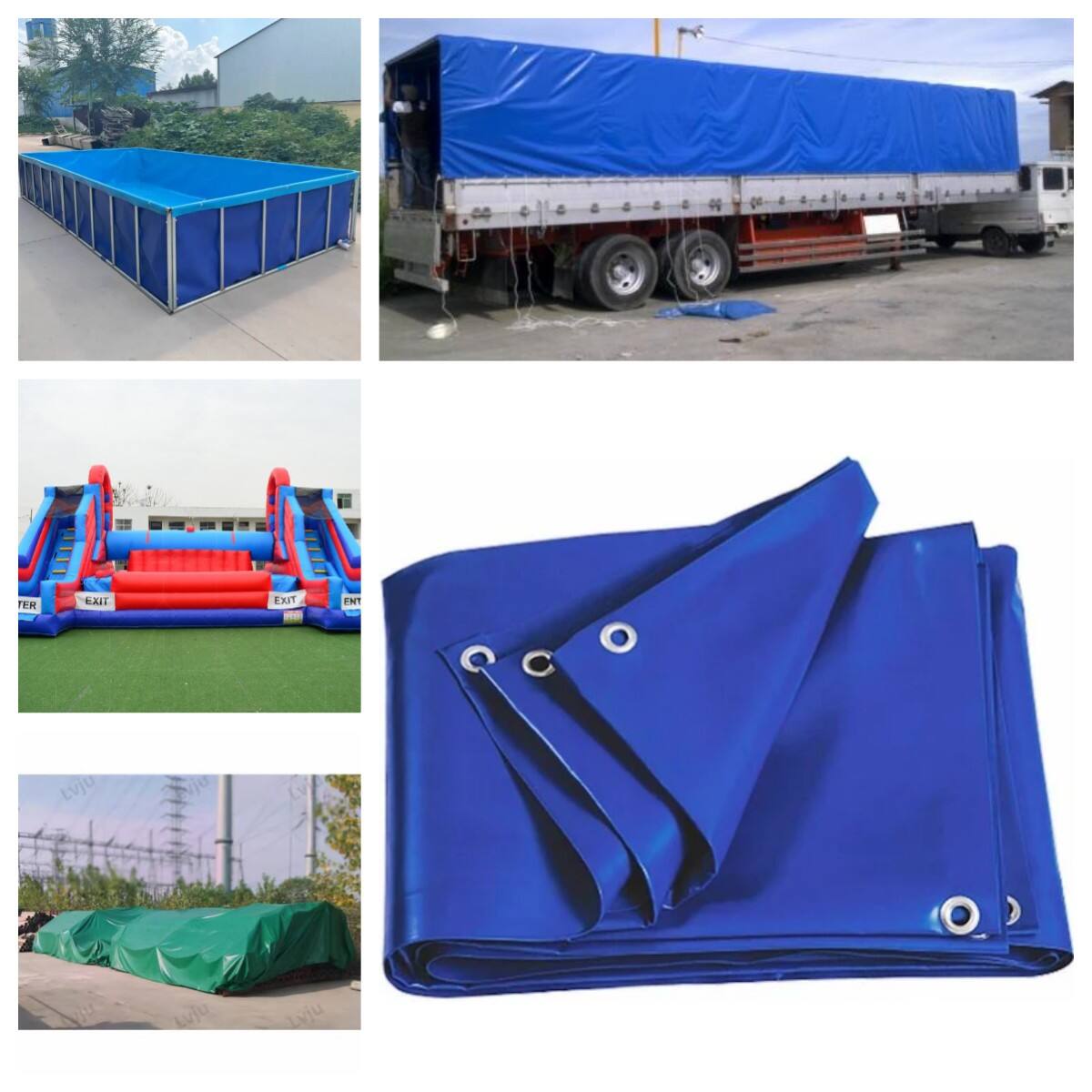ทำความเข้าใจเกี่ยวกับความทนทานและการผลิตผ้าใบ PVC
องค์ประกอบของวัสดุและการเสริมแรงด้วยไฟเบอร์กลาส
ผ้าใบ PVC มีความโดดเด่นเรื่องความทนทานยาวนาน ซึ่งเป็นผลมาจากวัสดุที่ใช้ในการผลิต โดยแกนหลักของผ้าใบเหล่านี้คือโพลีไวนิลคลอไรด์ (Polyvinyl Chloride) หรือที่เรียกกันทั่วไปว่า PVC ผู้ผลิตมักใช้ผ้าใบโพลีเอสเตอร์เป็นวัสดุฐาน จากนั้นจึงเคลือบด้วยเรซินแบบพัสดุ PVC ที่ผสมสารเติมแต่งที่เป็นประโยชน์ต่าง ๆ เช่น สารป้องกันเชื้อรา และสารควบคุมไฟฟ้าสถิต สารเหล่านี้ช่วยปกป้องผ้าใบจากความเสียหายจากแสง UV และการสึกหรอจากการใช้งานในระยะยาว สำหรับงานที่ต้องการความแข็งแรงเป็นพิเศษ ผู้ผลิตบางรายยังเสริมโครงสร้างด้วยไฟเบอร์กลาส (Fiberglass) การเสริมนี้ช่วยเพิ่มความแข็งแรงและความทนทานของผลิตภัณฑ์ได้อย่างมาก ตาข่ายไฟเบอร์กลาสช่วยเพิ่มความแข็งและป้องกันไม่ให้ผ้าใบย้วยหรือยืดตัวเมื่อถูกแรงกดดัน นี่จึงเป็นเหตุผลว่าทำไมผ้าใบชนิดเสริมแรงนี้จึงถูกใช้งานหนักตามไซต์ก่อสร้างและฟาร์ม ที่ซึ่งผ้าใบธรรมดาอาจเสียหายได้อย่างรวดเร็ว จริง ๆ แล้วมาตรฐานอุตสาหกรรมยังกำหนดไว้อย่างชัดเจนว่าจะต้องใช้วัสดุใดบ้าง เพื่อให้ทุกคนมั่นใจได้ว่าผ้าใบ PVC ที่ผลิตออกมามีความปลอดภัยและการทำงานที่เชื่อถือได้ ทั้งหมดนี้คือองค์ประกอบที่รวมกันจนกลายเป็นผ้าใบ PVC ที่ทนทาน ซึ่งผู้คนต่างพึ่งพาในการใช้งานอย่างต่อเนื่องในอุตสาหกรรมต่าง ๆ
ความทนทานต่อการฉีกขาดและการเสียดสี
ผ้าใบ PVC ถูกผลิตมาให้มีความทนทานต่อการฉีกขาดและการสึกกร่อนได้ดีมาก ซึ่งทำให้มันใช้งานได้ดีกว่าผ้าใบปกติมากในสภาพแวดล้อมที่ยากลำบาก ผู้ผลิตมักจะทดสอบผ้าใบเหล่านี้อย่างหลากหลายก่อนที่จะนำออกวางจำหน่าย พวกเขาตรวจสอบคุณสมบัติต่างๆ เช่น ความแข็งแรงของวัสดุเมื่อถูกดึงออก และความสามารถในการรับมือกับการถูกวัตถุแหลมคมทิ่มแทงโดยที่ไม่เกิดการฉีกขาด ลองดูว่าเกิดอะไรขึ้นในสถานที่ก่อสร้างที่เครื่องจักรหนักๆ ชนเข้ากับผ้าใบคลุมอยู่ตลอดเวลา ผ้าใบ PVC สามารถทนทานต่อสภาพเช่นนั้นได้ดีกว่าทางเลือกอื่นๆ มาก มีงานวิจัยชี้ให้เห็นว่า PVC สามารถต้านทานแรงฉีกขาดได้สูงกว่าวัสดุอื่นๆ ประมาณ 30% จากการทดสอบที่เผยแพร่ในวารสาร Journal of Applied Polymer Science เมื่อปี 2021 ผู้เชี่ยวชาญด้านวัสดุอุตสาหกรรมมักจะชี้ให้เห็นว่าโดยรวมแล้ว PVC มีอายุการใช้งานที่ยาวนานกว่า ทีมงานก่อสร้าง สถานที่จัดเก็บสินค้ากลางแจ้ง และแม้แต่กิจการด้านการเกษตร มักเลือกใช้ผ้าใบ PVC เพราะมันไม่เสื่อมสภาพเร็วเมื่อถูกแสงแดด ฝน หรือการใช้งานที่หยาบกระโชก
ความทนทานในสภาพแวดล้อมที่รุนแรง
พีวีซี (PVC) มีคุณสมบัติที่น่าประทับใจหลายประการ ซึ่งช่วยให้มันทนทานต่อสภาพแวดล้อมที่เลวร้ายได้เป็นปีๆ มันสามารถทนต่อทั้งอุณหภูมิเย็นจัดและอากาศร้อนระอุได้ดี ซึ่งหมายความว่าใช้งานได้อย่างน่าเชื่อถือในทุกเขตภูมิอากาศ ช่างก่อสร้างและเกษตรกรบ่อยครั้งมักพูดถึงความทนทานของผ้าใบพีวีซีที่ยังคงมีสภาพดี แม้จะต้องเผชิญกับสภาพแวดล้อมที่โหดร้ายทุกวัน ยกตัวอย่างเช่นในธุรกิจการเกษตร ชาวไร่ชาวนาหลายคนใช้ผ้าใบเหล่านี้เพื่อปกป้องรถบรรทุกและเครื่องจักรกลการเกษตรจากความเสียหายจากแสงแดดและฝน โดยไม่ต้องกังวลว่าผ้าใบจะเสื่อมสภาพอย่างรวดเร็ว ต้องการให้ผ้าใบพีวีซีของคุณใช้งานได้นานขึ้นหรือไม่? เพียงแค่คุณมีวินัยในการดูแลรักษา เช่น ใช้ผ้าชุบน้ำสบู่ถูทำความสะอาดเป็นระยะ และเก็บให้ห่างจากวัตถุมีคมที่อาจทำให้ผิวหน้าผ้าใบเกิดรอยรั่วหรือรอยทะลุ วิธีการดูแลรักษาง่ายๆ แบบนี้จะช่วยให้ผ้าใบยังคงประสิทธิภาพในการป้องกันได้อย่างเต็มที่ และสร้างคุณค่าสูงสุดให้กับวัสดุที่ใช้งาน
คุณสมบัติกันสภาพอากาศสำหรับทุกฤดูกาล
การป้องกันรังสีอัลตราไวโอเลตและกันน้ำ
ผ้าใบ PVC ส่วนใหญ่มักมีการป้องกันรังสี UV ในตัว ซึ่งเป็นสิ่งสำคัญมากเมื่อถูกแสงแดดส่องตลอดเวลา โดยปกติแล้วผู้ผลิตจะเคลือบผ้าใบด้วยสารพิเศษที่ช่วยดูดซับหรือสะท้อนรังสี UV ที่เป็นอันตรายเหล่านั้น ทำให้วัสดุยังคงความแข็งแรงทนทาน หากรถยนต์ไม่ได้รับการป้องกัน ผ้าใบดังกล่าวมักจะเสื่อมสภาพลงตามกาลเวลา เกิดความเปราะและสุดท้ายก็ฉีกขาด กล่าวถึงเรื่องการป้องกันแล้ว ผ้าใบ PVC ยังสามารถต้านทานน้ำได้ดีเยี่ยมเนื่องจากโครงสร้างที่กันน้ำได้โดยสมบูรณ์ ฝนจึงไหลผ่านผ้าใบแทนที่จะซึมเข้าไป ซึ่งเป็นคุณสมบัติที่มีความแตกต่างอย่างมากในพื้นที่ที่มักมีพายุฝนพัดผ่านเป็นประจำ ผลการทดสอบแสดงให้เห็นว่า ผ้าใบซึ่งได้รับการเคลือบรักษาจาก UV เป็นอย่างดี มักจะมีอายุการใช้งานยาวนานกว่าผ้าใบธรรมดาหลายปี หมายความว่าให้คุ้มค่ามากขึ้นในระยะยาว
คุณสมบัติต้านทานลม หิมะ และการลุกไหม้
ผ้าใบ PVC ทนต่อสภาพอากาศที่เลวร้ายได้ดี เนื่องจากมีคุณสมบัติพิเศษที่ช่วยให้มันใช้งานได้ดีแม้ต้องเผชิญกับลมแรงและหิมะตกหนัก วัสดุเองมีความแข็งแรงทนทานและไม่ฉีกขาดง่ายแม้ในสภาวะที่เลวร้ายเป็นพิเศษ ผู้ผลิตหลายรายยังทำการเคลือบผ้าใบเหล่านี้ด้วยสารเคมีพิเศษเพื่อทำให้มันมีคุณสมบัติต้านทานไฟซึ่งช่วยลดความเสียหายที่อาจเกิดจากเปลวไฟ รุ่นกันไฟผ่านการทดสอบอย่างเข้มงวดตามมาตรฐานความปลอดภัยที่เป็นที่ยอมรับ ดังนั้นบุคคลที่ทำงานในพื้นที่เสี่ยงอันตรายจึงมั่นใจได้ว่าได้รับการปกป้องที่มีคุณภาพ ทีมงานก่อสร้างและผู้จัดงานเห็นว่าการผสมผสานระหว่างความแข็งแรงและความต้านทานไฟนี้มีคุณค่าอย่างยิ่งต่อการดำเนินงานของพวกเขา เนื่องจากอุบัติเหตุเกิดขึ้นบ่อยครั้งตามสถานที่ก่อสร้างและงานเทศกาลต่าง ๆ
ประสิทธิภาพในอุณหภูมิสุดขั้ว
ผ้าใบ PVC ทนทานมากเมื่อเจอกับสภาพอากาศที่ร้อนจัดหรือเย็นจัด พวกมันยังคงความยืดหยุ่นได้ดีโดยไม่แตกร้าวหรือเสื่อมสภาพไม่ว่าสภาพอากาศจะเปลี่ยนแปลงไปมากเพียงใด ผลการทดสอบในห้องทดลองแสดงให้เห็นว่าผ้าใบเหล่านี้รักษารูปร่างได้ดี โดยไม่ขยายตัวหรือหดตัวมากแม้อุณหภูมิจะเปลี่ยนแปลงอย่างรวดเร็วจากวันหนึ่งไปอีกวันหนึ่ง ผู้คนที่อาศัยอยู่ในพื้นที่ที่ฤดูร้อนสามารถทำให้ยางมะตอยละลายและฤดูหนาวทำให้ถนนกลายเป็นน้ำแข็งมักพูดถึงความทนทานของผ้าใบเหล่านี้มาเป็นเวลานาน ผู้ผลิตเองก็ทราบดีว่าอะไรคือสิ่งที่ได้ผลดีที่สุด หลังจากผ่านพ้นพายุฝุ่นในทะเลทรายและพายุหิมะในเขตขั้วโลก พวกเขาได้ออกแบบผ้าใบโดยเพิ่มสารเคลือบพิเศษและสารเติมแต่งที่ช่วยต้านทานความเสียหายจากความร้อนและน้ำแข็ง ดังนั้นผู้ใช้งานจึงไม่ต้องกังวลว่าผ้าใบจะเสียหายในช่วงเวลาสำคัญท่ามกลางสภาพแวดล้อมที่เลวร้าย
การใช้งานที่หลากหลายในอุตสาหกรรมและการพาณิชย์
บริเวณสถานที่ก่อสร้างและการผสมผสานตาข่ายไฟเบอร์กลาส
ทีมงานก่อสร้างพึ่งพาผ้าใบ PVC เป็นอย่างมาก เพราะมีอายุการใช้งานยาวนานกว่าและให้การปกป้องที่ดีกว่าทางเลือกอื่น ๆ ผ้าใบเหล่านี้สามารถทนต่อฝน ลม และแม้แต่หิมะ โดยไม่ทำให้โครงการล่าช้า แต่สิ่งที่ทำให้พวกมันมีประสิทธิภาพใช้งานได้ดีจริง ๆ คือการใช้งานคู่กับตาข่ายไฟเบอร์กลาส เมื่อช่างติดตั้งตาข่ายนี้ไว้ด้านล่างผ้าใบ จะช่วยเสริมความแข็งแรงได้อย่างมาก ป้องกันไม่ให้รอยฉีกขาดลุกลามไปทั่วผืนผ้า เราได้เห็นระบบนี้ช่วยป้องกันอุบัติเหตุหลายครั้งในพื้นที่ก่อสร้างที่มีการจัดเก็บวัสดุหนักไว้ภายนอกอาคาร นอกจากนี้ กฎความปลอดภัยจากองค์กรเช่น OSHA ยังกำหนดให้มีมาตรการป้องกันบางอย่างไว้ในพื้นที่ก่อสร้างอยู่แล้ว ดังนั้นการใช้ผ้าใบเสริมแรงแบบนี้จึงไม่ใช่เพียงแค่แนวทางปฏิบัติที่ชาญฉลาด แต่ยังแทบจะเป็นสิ่งบังคับสำหรับการดำเนินงานขนาดกลางหรือใหญ่
การใช้งานในภาคเกษตรกรรมและการแก้ไขปัญหาการจัดเก็บกลางแจ้ง
ผ้าใบ PVC กลายเป็นสิ่งที่สำคัญมากสำหรับการปกป้องสิ่งต่าง ๆ ในการดำเนินงานด้านการเกษตร ชาวนาใช้ผ้าใบกันฝนเหล่านี้คลุมเครื่องจักรราคาแพงของพวกเขา เพื่อป้องกันความเสียหายจากฝน หิมะ และแสงแดด ซึ่งหมายความว่ารถแทรกเตอร์และเครื่องเก็บเกี่ยวจะมีอายุการใช้งานที่ยาวนานกว่าที่ควรจะเป็น ในการเก็บรักษาอุปกรณ์ไว้ภายนอกอาคาร วัสดุกันน้ำที่มีความหนาจะช่วยทำให้สิ่งของด้านในแห้งอยู่ตลอดเวลา ขณะเดียวกันยังคงให้อากาศสามารถถ่ายเทได้รอบอุปกรณ์ งานวิจัยบางส่วนชี้ให้เห็นว่า เมื่อเกษตรกรเริ่มใช้ผ้าใบ PVC ที่มีคุณภาพอย่างสม่ำเสมอ ไม่เพียงแต่เครื่องมือของพวกเขาจะอยู่ในสภาพที่ดีขึ้นในระยะยาวเท่านั้น แต่ยังมีผลผลิตที่ได้จากไร่นาดีขึ้นด้วย สิ่งนี้มีเหตุผล เนื่องจากการปกป้องการลงทุนจะนำไปสู่ผลลัพธ์ที่ดีขึ้นโดยรวมในธุรกิจการเกษตรเกือบทุกด้าน
ที่พักพิงฉุกเฉิน และทางเลือกอื่นแทนผ้าห่มดับเพลิง
ผ้าใบ PVC เป็นวัสดุที่มีความหลากหลายในการใช้งานสูงมาก ซึ่งทำให้มันจำเป็นอย่างยิ่งในสถานการณ์ฉุกเฉิน เมื่อประชาชนต้องการที่พักชั่วคราวหลังจากเกิดภัยพิบัติทางธรรมชาติ ผ้าใบเหล่านี้สามารถทนต่อสภาพอากาศทุกประเภท และช่วยให้ผู้คนอยู่อย่างปลอดภัยแม้ในกรณีที่อาคารปกติไม่สามารถใช้งานได้ สิ่งที่หลายคนอาจไม่ทราบคือ ผ้าใบเหล่านี้สามารถใช้แทนผ้าห่มดับเพลิงได้ดีมากเช่นกัน มีการทดสอบบางอย่างแสดงให้เห็นว่า ผ้าใบเหล่านี้มีประสิทธิภาพเทียบเท่ากับผ้าห่มดับเพลิงมาตรฐาน และบางครั้งยังสามารถดับไฟได้ดีกว่าเสียด้วย หน่วยดับเพลิงทั่วประเทศจึงเริ่มนำผ้าใบ PVC เข้าไว้ในอุปกรณ์ฉุกเฉินเนื่องจากวัตถุประสงค์การใช้งานที่หลากหลายนี้ วัสดุนี้มีคุณสมบัติต้านทานการลุกติดไฟของตัวเอง ในขณะเดียวกันก็ยังคงให้การป้องกันที่มีประสิทธิภาพ จึงกลายเป็นอุปกรณ์มาตรฐานสำหรับเจ้าหน้าที่ที่ต้องรับมือกับสถานการณ์ที่ไม่แน่นอนในพื้นที่เกิดเหตุ
การดูแลรักษาผ้าใบพีวีซีเพื่อการใช้งานระยะยาว
แนวทางที่ดีที่สุดในการทำความสะอาดและเก็บรักษา
หากเราต้องการให้ผ้าใบ PVC มีอายุการใช้งานเป็นปีๆ แทนที่จะใช้ได้เพียงไม่กี่เดือน การทำความสะอาดและเก็บรักษาให้ถูกวิธีมีความสำคัญอย่างมาก ขั้นตอนง่ายๆ มักจะได้ผลดีที่สุดในหลายกรณี ให้ใช้สบู่อ่อนๆ เช่น น้ำยาล้างจานเจือจางผสมกับน้ำ จากนั้นใช้แปรงขนอ่อนขัดทำความสะอาดให้ทั่ว วิธีนี้จะช่วยกำจัดสิ่งสกปรกและคราบไขมันโดยไม่ทำลายพื้นผิวพลาสติก เมื่อทำความสะอาดเสร็จแล้ว ล้างน้ำให้สะอาดทั้งหมดและปล่อยให้ผ้าใบแห้งสนิทก่อนจะเก็บเข้าที่ ควรหลีกเลี่ยงการพับผ้าใบเพราะจะทำให้เกิดรอยพับถาวรในระยะยาว การม้วนผ้าใบเพื่อเก็บจึงเป็นทางเลือกที่เหมาะสมกว่า หาที่เก็บที่มีอากาศเย็นและแห้ง ไม่ควรอยู่ใกล้แสงแดดโดยตรงหรือแหล่งความร้อน บางคนแนะนำว่าการใช้สเปรย์ป้องกันรังสี UV เป็นระยะๆ นั้นมีประโยชน์ ผลิตภัณฑ์เหล่านี้อาจช่วยให้สีสันดูดีขึ้น และรักษาความยืดหยุ่นของผ้าใบไว้ได้นานขึ้น แม้ว่าผลลัพธ์อาจแตกต่างกันไปตามระดับการสัมผัสแสงแดดของผ้าใบ
การซ่อมแซมรอยฉีกและความเสียหายเล็กน้อย
การรีบซ่อมแซมรอยฉีกขาดเล็กๆ บนผ้าใบ PVC ทันที จะช่วยให้ผ้าใบใช้งานได้นานขึ้นมาก หลายคนพบว่าของพื้นฐาน เช่น เทปซ่อมแซม ชุดซ่อมแซมพิเศษสำหรับ PVC หรือเพียงแค่ให้ความร้อนที่ขอบ ก็ใช้ได้ดีสำหรับการอุดรอยรั่วเล็กน้อย เมื่อใครสักคนหยิบชุดซ่อมแซมนั้นขึ้นมา ควรใช้เวลาทำความสะอาดบริเวณที่เสียหายก่อนเป็นอันดับแรก สิ่งสกปรกและความชื้นจะส่งผลต่อประสิทธิภาพในการยึดติดของแผ่นซ่อมแซม ต้องการทราบไหมว่าควรซ่อมหรือทิ้ง? ให้พิจารณาขนาดของรูและความใกล้เคียงกับขอบผ้าใบ จุดเล็กๆ ใกล้ๆ ขอบอาจซ่อมแซมได้ แต่ถ้ารูใหญ่กว่าเหรียญสิบบาทและอยู่ตรงกลาง ก็อาจถึงเวลาต้องซื้อผืนใหม่ สำหรับผู้ที่ยังไม่มั่นใจว่าควรทำอย่างไร ควรศึกษาคู่มือซ่อมแซมอย่างเป็นทางการจากผู้ผลิต หรือพูดคุยกับผู้ที่ทำงานเกี่ยวข้องกับวัสดุเหล่านี้โดยตรง ประสบการณ์จริงของพวกเขามักมีเคล็ดลับที่ไม่ได้มีอยู่ในคู่มือทั่วๆ ไป
การยืดอายุการใช้งานผ่านการดูแลที่เหมาะสม
ผ้าใบพีวีซีจะมีอายุการใช้งานที่ยาวนานขึ้นมาก หากได้รับการดูแลอย่างเหมาะสมและใช้งานอย่างมีสติ ควรตรวจสอบสภาพผ้าใบเป็นประจำเพื่อหาสัญญาณของความสึกหรอ และแก้ไขปัญหาเล็กๆ ทันทีที่พบ เพื่อป้องกันไม่ให้ปัญหาเล็กน้อยกลายเป็นปัญหาใหญ่ในอนาคต การใช้งานก็มีความสำคัญเช่นกัน ไม่มีใครต้องการลากผ้าใบบนพื้นขรุข rough หรือปล่อยให้ผ้าใบเสียดสีกับขอบแหลมคมที่จะทำให้วัสดุเกิดรอยรั่วหรือฉีกขาดได้ จากประสบการณ์ในอุตสาหกรรมพบซ้ำแล้วซ้ำอีกว่า ผู้ที่ดูแลรักษาผ้าใบของตนเองอย่างดี มักจะใช้จ่ายเงินน้อยลงในการซื้อผ้าใบใหม่ เพราะไม่จำเป็นต้องเปลี่ยนผ้าใบบ่อยนัก การปฏิบัติตามหลักการบำรุงรักษาพื้นฐานจะช่วยให้ผ้าใบเหล่านี้ใช้งานได้ดีและทนทานภายใต้สภาวะปกติเป็นเวลานานหลายปีแทนที่จะเป็นเพียงไม่กี่เดือน

